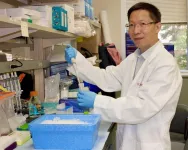(Press-News.org) INDIANAPOLIS - Indiana University School of Medicine researchers have made a significant breakthrough in developing a new gene therapy approach that restores full-length dystrophin protein, which could lead to new treatments for people with Duchenne muscular dystrophy (DMD).
The study, recently published in Nature Communications, demonstrates the effectiveness of their novel gene therapy technology in improving muscle tissue and overall strength in mice models with Duchenne muscular dystrophy.
Duchenne muscular dystrophy is a genetic disorder caused by mutations in the DMD gene, resulting in a lack of the protein dystrophin. This deficiency leads to progressive muscle weakness and loss of muscle tissue over time. Patients with the disease experience impaired mobility, heart and lung problems, and ultimately a shortened life expectancy.
“Current gene therapy for Duchenne muscular dystrophy utilizes a truncated version of dystrophin,” said Renzhi Han, PhD, senior author of the study and professor of pediatrics at the IU School of Medicine. “Unfortunately, this option doesn’t fully protect the muscles because it lacks many important functional domains of full-length dystrophin."
While the U.S. Food and Drug Administration recently approved a micro-dystrophin gene therapy for Duchenne muscular dystrophy, Han said the therapeutic outcomes have been less satisfactory than expected.
Building on their experience using adeno-associated virus methods to deliver extra-large therapeutic genes into cells, Han and his team at the Herman B Wells Center for Pediatric Research developed a triple-adeno-associated virus vector system to deliver a complete version of the dystrophin protein into the muscles.
"We optimized and tested our new three-vector system to make sure it produced and assembled the full-length dystrophin protein effectively," Han said. "Our data confirmed we successfully restored full-length dystrophin in both the skeletal and heart muscles of mice with DMD, leading to significant improvements in their muscle health, strength and function.”
Han has filed a provisional patent application for his triple-adeno-associated virus vector system and is collaborating with the IU Innovation and Commercialization Office to advance the treatment toward market availability. He is also seeking additional funding so patients with Duchenne muscular dystrophy have access to promising new treatment options.
"I believe this new gene therapy approach offers significant advantages to patients compared to what they currently have available, and I'm eager to get it into further clinical development," he said.
Other IU School of Medicine study authors include Yuan Zhou, Chen Zhang, Weidong Xiao and Roland W. Herzog.
About the IU School of Medicine
The IU School of Medicine is the largest medical school in the U.S. and is annually ranked among the top medical schools in the nation by U.S. News & World Report. The school offers high-quality medical education, access to leading medical research and rich campus life in nine Indiana cities, including rural and urban locations consistently recognized for livability. According to the Blue Ridge Institute for Medical Research, the IU School of Medicine ranks No. 13 in 2023 National Institutes of Health funding among all public medical schools in the country.
Writer: Jackie Maupin, jacmaup@iu.edu
Source: Renzhi Han, rh11@iu.edu
For more news, visit the IU School of Medicine Newsroom: medicine.iu.edu/news
Follow us on X: @IUMedSchool
END
New gene therapy approach shows promise for Duchenne muscular dystrophy
2024-07-25
ELSE PRESS RELEASES FROM THIS DATE:
Chemical analyses find hidden elements from renaissance astronomer Tycho Brahe’s alchemy laboratory
2024-07-25
In the Middle Ages, alchemists were notoriously secretive and didn’t share their knowledge with others. Danish Tycho Brahe was no exception. Consequently, we don’t know precisely what he did in the alchemical laboratory located beneath his combined residence and observatory, Uraniborg, on the now Swedish island of Ven.
Only a few of his alchemical recipes have survived, and today, there are very few remnants of his laboratory. Uraniborg was demolished after his death in 1601, and the building materials were scattered for reuse.
However, during an excavation ...
Pacific Northwest launches clean hydrogen energy hub
2024-07-25
RICHLAND, Wash.—The Pacific Northwest is set to begin work building out a clean hydrogen economy with today’s announcement of a Phase 1 funding award from the Department of Energy. The $27.5 million award to the Pacific Northwest Hydrogen Association (PNWH2), a multi-state nonprofit organization, will be matched by industry partners up to $125 million in Phase 1 of the project.
DOE’s Pacific Northwest National Laboratory will serve as an advisor to the PNWH2 by conducting life-cycle analysis to predict and understand the planned hydrogen energy infrastructure impact on decreasing emissions and aiding in community engagement.
Public ...
Tiny deletion in heart muscle protein briefly affects embryonic ventricles but has long-term effects on adult atrial fibrillation
2024-07-25
BIRMINGHAM, Ala. – Millions of adults have atrial fibrillation — an irregular beating of the upper chambers of the heart that yields increased risk of heart failure, stroke and death. Many genetic mutations in the developing fetus can lead to adult atrial fibrillation, including mutations that shorten the massive protein titin in cardiac muscle cells.
Now, in a study in zebrafish and human heart muscle cells, researchers show that a tiny deletion in the A-band of titin — the loss of just nine amino acids out of more than 27,000 to 35,000 amino acids of an intact titin protein — causes a developmental ...
Harms of prescribing NSAIDs to high risk groups estimated to cost NHS £31m over 10 years
2024-07-25
Prescribing non-steroidal anti-inflammatory drugs (NSAIDs) to people at high risk of harm from them is estimated to cost the NHS in England around £31 million and cause more than 6,000 lost years of good health over 10 years, finds a study published by The BMJ today.
NSAIDs continue to be a source of avoidable harm and healthcare costs, and more needs to be done to address this, especially in high risk groups, say the researchers.
NSAIDs are used for pain and inflammation and are one of the most widely prescribed groups of medicines in the world, But they are known to increase the risk of gastrointestinal bleeding, heart attacks, stroke, and kidney damage.
Yet ...
Wearing a face mask in public spaces cuts risk of common respiratory symptoms, suggests Norway study
2024-07-25
Wearing a surgical face mask in public spaces reduces the risk of self-reported respiratory symptoms, finds a trial of adults in Norway published by The BMJ today.
The effect was moderate - a 3.2% reduction in symptoms, equivalent to around 3,300 fewer infections per 100,000 people - but the researchers say these results support the claim that face masks may be an effective measure to reduce the rate of self-reported symptoms consistent with respiratory tract infections.
Observational studies suggest that face masks reduce the risk of respiratory tract infections, but findings from randomised ...
Some private biobanks overinflating the value of umbilical cord blood banking in marketing to expectant parents
2024-07-25
Some private UK biobanks may be misleading expectant parents about the value of storing umbilical cord blood to treat life-threatening diseases that may arise in their child in the future, reveals an investigation by The BMJ, published today.
Over the past decade growing numbers of parents have chosen to store blood from the umbilical cord, which contains stem cells, in case their infant develops a condition that could be treated with stem cell therapy.
Parents must use a private biobank which charges around £550 ...
New research in fatty liver disease aims to help with early intervention
2024-07-25
A new study brings researchers closer to better understanding the pathology of the fatty liver disease MASH, which stands for metabolic dysfunction-associated steatohepatitis.
MASH is a consequence of poor diet and obesity and results in severe damage to the liver. In MASH, the liver becomes filled with active and rapidly multiplying T cells, which are a type of immune cell.
In today’s study, published in Hepatology, researchers examine what these T cells look like and how they work in people with liver cirrhosis (a late stage of liver disease) and in an animal ...
Genetics reveal ancient trade routes and path to domestication of the Four Corners potato
2024-07-25
A new study shows that a native potato species was brought to southern Utah by Indigenous people in the distant past, adding to an ever-growing list of culturally significant plant species that pre-contact cultures domesticated in the Southwestern U.S.
The team of researchers, led by Red Butte Garden and the Natural History Museum of Utah (NHMU) at the University of Utah, used genetic analysis to reveal how and where tubers of the Four Corners potato (Solanum jamesii) had been collected, transported and traded throughout the Colorado Plateau. The findings support the assertion that the tuber is a “lost sister,” joining maize, beans and squash—commonly ...
SNIS 2024: New study shows critical improvements in treating rare eye cancer in children
2024-07-25
FOR IMMEDIATE RELEASE: July 24, 2024, 3:20 P.M. MDT
CONTACT: Camille Jewell
cjewell@vancomm.com or 202-248-5460
COLORADO SPRINGS, Colo. — The evolution of retinoblastoma treatment over the past 15 years has resulted in a higher likelihood of vision preservation without compromising survival, according to research released today at the Society of NeuroInterventional Surgery’s (SNIS) 21st Annual Meeting.
Retinoblastoma, a rare eye cancer that affects young children, carries a risk of impaired vision and removal ...
Wearable devices can increase health anxiety. Could they adversely affect health?
2024-07-24
Using a wearable device, such as a smart watch, to track health data and symptoms, is supposed to help people monitor their health and address symptoms as quickly as possible to spur positive health outcomes. But for people with atrial fibrillation, also known as Afib, using a wearable device to monitor the heart rate and to alert wearers of an irregular heartbeat might not be as helpful as wearers think.
A new study in the Journal of the American Heart Association, led by Lindsay Rosman, PhD, assistant professor of medicine in the ...






